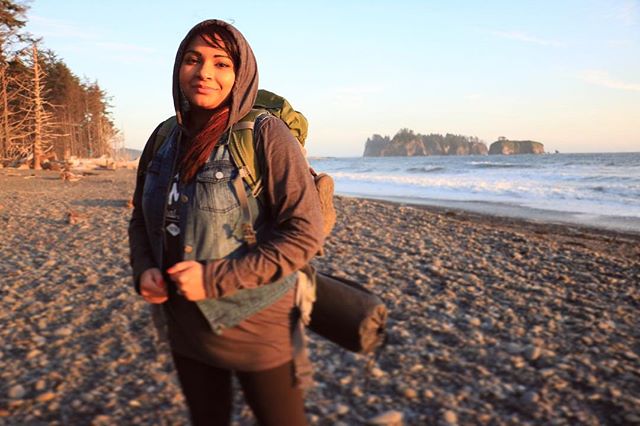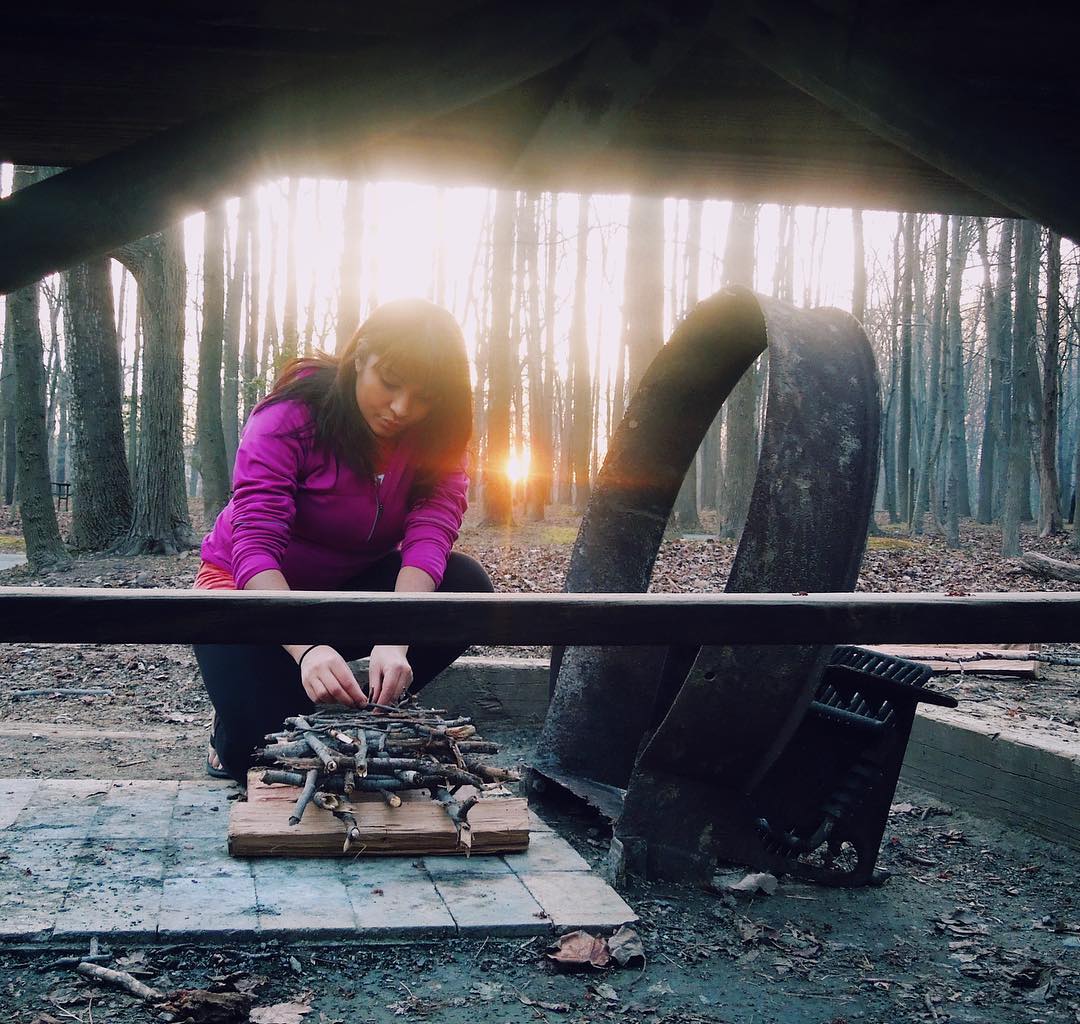
In 2018, Ambreen Tariq’s story of the outdoors is camping, hiking and sightseeing. It is a promise of an annual trip to Shenandoah National Park on her birthday and skies that swirl slate blue into pink. It is a solid social media following and a demanding side-hustle. It is a hashtag.
But twenty years ago, Tariq’s story of the outdoors is immigration.
“My parents got bare minimum equipment. They were working two jobs each,” she says. “And at that time it didn’t strike me as odd because that was really my experience.”
Tariq’s first memories of the outdoors are of staying afloat in a strange culture that held the dream of a better future, and that meant assimilating to the American pastimes her family saw in its mostly white community. From the moment they immigrated from India to the United States, the most valuable survival tool for Tariq’s family was mimicry. That included camping trips to local outdoor spots during the Minnesota summers, even if it meant scrounging department stores for cheap equipment or constantly being aware of one’s own non-whiteness.
However foreign Tariq’s family may have seemed to others while camping in her childhood, she didn’t notice her differences until she started to engage in outdoor activities as an adult. Decades after she arrived in the U.S., she noticed that the whiteness in the parks and trails she frequented hadn’t improved. And so, she decided to write about it. First, in a personal blog, and then with the hashtag #BrownPeopleCamping.
But the real spark for Tariq arrived in 2015, the centennial of the National Park Service, when she realized the true potential for a hashtag-driven movement on social media. The NPS was celebrating its 100th birthday with the Find Your Park campaign, a movement based in digital storytelling and community-building around the hashtag #FindYourPark.
“I felt like there was a community out there that was much bigger than me that had been talking about this for a long time,” she says.
Inspired by the power of the movement, Tariq expanded #BrownPeopleCamping into @brownpeoplecamping in August 2016, creating her own community on Instagram.
Just 18 months later, Brown People Camping’s account boasts almost 15,000 followers. In fact, it has become much more than an aesthetically-pleasing Instagram profile. The way Tariq sees it, she is the mother of a community that has come together in the belief that everyone can belong in the outdoors. While most of the photos reflect Tariq’s personal narrative as she navigates the picturesque landscapes of America’s national parks, she also chooses to engage with her followers, both admirers and critics, honoring the stories of all who want to participate.
The goal is to create a movement, an immovable force of people demanding representation. Stemming from struggles for desegregated and equal access to physical spaces during the Civil Rights Movement to calls for clean water in Flint, Michigan, minorities have been fighting for equality in the environment for years. And despite historical efforts, a 2015 NPS survey showed that only 20 percent of visitors, volunteers and staff in all of the United States’ national parks that year were nonwhite. Activists have picked up on this paucity of color, and many have adopted social media as a powerful tool to recruit like-minded people the world over.
Tariq is one of these social media trailblazers. She knows that @brownpeoplecamping is not an island. She points to other Instagram accounts like Unlikely Hikers and Melanin Base Camp, as well as organizations like Outdoor Afro and Latino Outdoors, as partners in a coalition of people turning up the dial on their visibility in the environmental movement.
As it spreads, a wide network of digital advocates allows Tariq to stay authentic to the stories she shares and the causes she supports. Everything—photos, comments, sponsorships—is painted in her image and filtered through her story.
“I just wanted to get to the conversations and not curate them to somebody else’s voice,” she says. “I’m not trying to speak for anybody else.”
With this strategy, Brown People Camping is a fitting complement to the work of many other Instagram accounts that instead focus on community submissions and rarely reveal information about its creator. For Tariq, showing her face and story has allowed her to foster a genuine connection with her audience.
But as Tariq posted more about the inclusion of brown faces in the outdoors and the Instagram account grew in popularity, so did the whiteness of her audience.
“I was like, listen, I feel lonely out here, I want people of color of out here,” Tariq says of her intentions at the start of Brown People Camping. “But the vast majority of people that started responding to me, that started encouraging me, that supported me when I got backlash, were white people.”
Every post of Tariq’s is met with both support and backlash. A recent post from March 13 shows a screenshot amalgamation of angry comments such as: “I need to make me an ALL WHITE hiking group. Since we like to be racist around here.”
But supportive commenters are quick to come back, for example: “Still a lot of fragile white people out there, ignore them.”
But instead of becoming frustrated with an audience of people who didn’t share her racial identity, Tariq used her channel’s demographics to her advantage. Even though they weren’t brown, her followers were still deeply invested in diversity and willing to exchange personal vulnerabilities about their own struggles. These common characteristics are what drew Tariq and her following closer together.
Tariq soon realized that if she wanted to shift outdoor culture in the community she had unintentionally created, her new platform would have to be centered in allyship.
“That’s the reality,” she says. “My project is going to remain focused on connecting diverse folks with allies so that we can grow our movement together.”
Tariq has fully embraced the role of environmental diversity liaison, centering brown faces in photos, while engaging white supporters in the comments. But she always does it through her own lens. Lately, that has been one of outdoor culinary exploration. Harkening back to her childhood camping experiences, Tariq’s mother cooked what she knew, leaning on Indian recipes like Tandoori chicken instead of American camping classics like PB&J on white tortillas. And now, Tariq is acting in the shadow of her mother’s spirit.
There’s one indisputable fact: everybody eats. Tariq’s ability to reach others through a common understanding of food has made permissible the idea of bringing one’s whole, multi-faceted, multi-hyphenated, identity into the outdoors.
“Whenever I share something that I learned to cook in the outdoors, people will be like, ‘I never thought of trying that out there,’” she says. “People don’t think that they’re bringing themselves out there. Like you’re mimicking this very binary outdoor culture. It doesn’t have to be that way.”
Her deep interest in the mechanics, challenges and creativity of outdoor cooking has even inspired Tariq to consider the possibility of a cookbook. However, she still believes that she needs to take time to gain experience and grow her directory of recipes at her own pace. In the interim, she will continue to experiment with dishes that both remind her of home and dip into other international cultures. She says, “Food is a beautiful way that everyone celebrates diversity. If you like chicken you’re going to love Tandoori chicken, you know what I mean? So, I really use food as a way to exemplify the beauty of diversity in the outdoors.”
With her long-term goals in the back of her mind—her cookbook, her partnerships with big-time companies like REI, her relationships with other social media leaders—Tariq stays grounded in a constant acknowledgement of the privileges that allow Brown People Camping to exist as the small-ish, tight-knit community she wants to be. After all, outside of the Instagram account, Tariq enjoys a salaried full-time job and a private life at home with her husband. So when it comes to the future of Brown People Camping, she shrugs off the possibility of it becoming a multimillion dollar brand or big-time nonprofit. Instead she vies for conservative growth founded in authentic allyship, shared stories and inspirational messaging.
“What’s moving to me is when people tell me that ‘because of you, I got out there,’” she says. “And it’s just moves me. And I love it. I absolutely love it.”
In her latest post, Tariq is photographed kneeling by a stack of campfire wood. She is backlit by the orange-yellow of a luminous setting sun that leaks through the trees of Shenandoah National Park. She builds the base for the fire with a calm focus. We do not know how many times she tried and failed to light the fire that night, or if she burned her tandoori chicken amongst the flames, or how many minutes she spent in search of the perfect shot before the cloak of dark. But with each rising tension, we see Tariq cradle it gracefully in her smile. She invites the complexities of the lands to which she immigrated so many years ago, and of the people that recreate there today. To her they are made of more than just natural beauty.
“To be able to say, ‘this is not just a pretty picture of a tree or a mountain—someone lived here before me, someone helped curate this land, someone donated this land, someone died here, someone will be born here’,” she says. “To put all of this in perspective is to celebrate diversity. And that’s extremely, extremely important for me.”

(Courtesy of @brownpeoplecamping)
